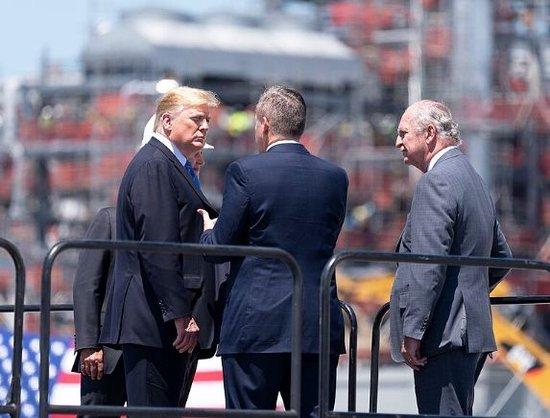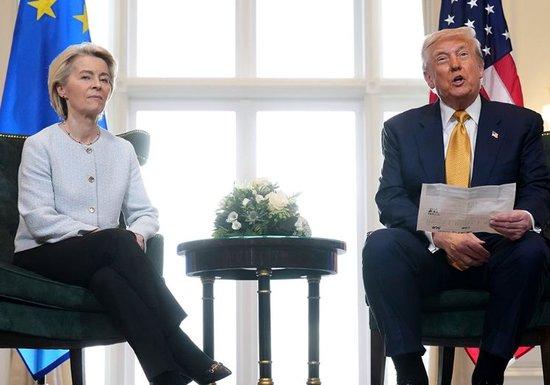

On August 1, the deadline for Trump’s administration to pressure its trading partners intensified, ultimately securing multiple “major energy deals.”
According to news reports, the Trump administration has received energy commitments from countries including Japan, South Korea, and the European Union. Under the agreement, the European Union is required to purchase $750 billion worth of American energy products within three years. South Korea pledged to invest $100 billion in energy, and Japan committed to substantial investment in American energy infrastructure.
After the agreement was signed, President Trump labeled it as a “great victory.” However, several former U.S. officials and analysts pointed out on July 31 that Trump’s pressure to commit countries to buy large amounts of American energy was more like “political propaganda,” lacking clarity and often not feasible due to the actual economic needs of the other parties and the United States’ own supply capabilities.
“This involves the so-called ‘political math’ we refer to as ‘politics,'” said an analyst when discussing the agreement reached with trade partners such as the European Union, Japan, and South Korea. “One of the best tools for diplomacy is ambiguity.”
According to the agreement reached between the U.S. and the European Union on the 27th, the EU committed to purchasing $750 billion worth of American energy products over three years, including crude oil, nuclear reactor fuel, natural gas, and other petroleum derivatives, with annual purchases exceeding triple the amount the EU had purchased from the U.S. last year.
Since the outbreak of the Russia-Ukraine conflict in 2022, the EU has sought to reduce its reliance on Russian energy and has begun buying more natural gas from the U.S., showing further intentions to increase its purchases. However, the annual $250 billion purchase volume will make the EU almost entirely dependent on the U.S. as its sole energy supplier.
Jason Fern, an analyst at Energy and Shipbrokers, stated: “The EU will only be able to stop buying from other countries, which would represent a significant dependence on a single country, whether it’s the U.S. or another country.”
However, the core of the modern energy system and supply lies in diversity.”
On July 27th, Trump and Von der Leyen met in Scotland to announce an agreement between the US and Europe. According to ClearView Energy Partners’ analysis of U.S. federal data, $250 billion accounts for about 80% of the total global energy exports of the United States by 2025. By 2030, the capacity for natural gas exports in the US is expected to double; however, in the short term, a significant increase in supply from the US to the EU may imply a reduction in exports to other global customers.
Reports indicate that countries have committed to purchasing American energy, but the details are vague. Analysts point out that at least in the short term, the amount of natural gas and other energy sources promised by trade partners of the US exceeds the needs of various countries as well as the US’s production capacity.
This approach adds a governmental intervention to transactions typically dominated by the market, and it remains unclear how or whether the EU can persuade private enterprises to purchase such large quantities of American energy. The US government also has no authority to direct its oil and gas companies to sell where they should. The EU recently announced plans to initiate a “special procedure” to gather member states’ demands and match them with appropriate supplies from the US. The statement said: “The US needs to ensure unrestricted access and sufficient production and export capabilities to support these purchases.”
Typical trade agreements include clauses allowing both parties to implement commitments regarding energy purchases, usually also specifying remedies for breaches. However, none of the recent agreements reached by the Trump administration included such clauses. When asked if the US would react negatively if the EU did not meet its energy purchase targets in three years, White House officials stated “tariffs will be increased.”
“This is a new phenomenon. Before this, trade agreements generally sought clarity and enforceability,” said David Goldwin, former US diplomat and energy department official. “These energy commitments are neither clear nor enforceable, more like political encouragement.”
”
Furthermore, it remains unclear how the trade agreement with the United States will impact the EU’s climate goals. In the short term, more natural gas could help achieve these targets through its substitution for coal, but excessive purchases of natural gas could squeeze the market share of clean energy sources such as wind and solar power. Previously, the overall demand for natural gas on the European continent was expected to decrease in the coming years.
Joseph Macutt, Director of the Energy Security and Climate Change Project at the Strategic and International Studies Institute, stated: “(Buying American energy) might replace some renewable energy deployments, but the reality is that the EU has a legally binding commitment to climate action.”
Analysts believe that the US and Europe may handle procurement flexibly. For example, the EU could purchase large oil tankers loaded with oil and gas without using them all up, reselling them to other global buyers. They might also delay implementation from three years to twenty years.
Kevin Bueck, Managing Director of ClearView Energy Partners, an American analysis firm, commented: “This involves the so-called ‘political math’, after all, one of the best tools for diplomacy is ambiguity.”
In May 2019, then-President Donald Trump visited an LNG export facility in the United States.
The report mentions that compared to the EU, Japan, South Korea, and the US have a more ambiguous energy purchasing framework, leaving more room for interpretation.
The White House once claimed that the significant expansion of U.S. energy exports would focus on “energy infrastructure and production,” part of Japan’s $550 billion investment commitment, without providing specific details. It remains unclear whether the value of signing a decades-long purchase agreement aligns with Japan’s pledge to reduce fossil fuel consumption.
The same logic applies to South Korea. South Korea committed to purchasing $100 billion worth of U.S. energy, but did not specify a deadline.
Michelle Kim, an energy expert at the Institute for Energy Economics and Financial Analysis, stated that purchasing on demand rather than signing long-term agreements would provide South Korea with more flexibility as natural gas demand decreases. She remarked, “Renewing long-term contracts again is not a wise decision.”
As early as July 27th, when the US-EU trade agreement was reached, Western commentators noticed that the figure of $750 billion seemed meaningless and impractical. They pointed out that on one hand, the United States struggles to supply such a large amount of energy products, making it highly unlikely to achieve such a vast energy supply chain in the short term; on the other hand, the EU’s energy demand growth is also limited.
To address external doubts, the European Commissioner for Trade, Severino Schicchi, emphasized, “We believe these figures are achievable… This is our proposal. We are ready to make purchases.”
“This is sheer fantasy,” noted Claude Russell, a columnist specializing in commodities and energy in Asia, pointing out that the EU’s annual commitment of $250 billion for energy imports is utterly unrealistic and unachievable. However, US and EU officials still agreed to this absurd figure, perhaps hoping to delay time until a “more cooperative” US President emerges.